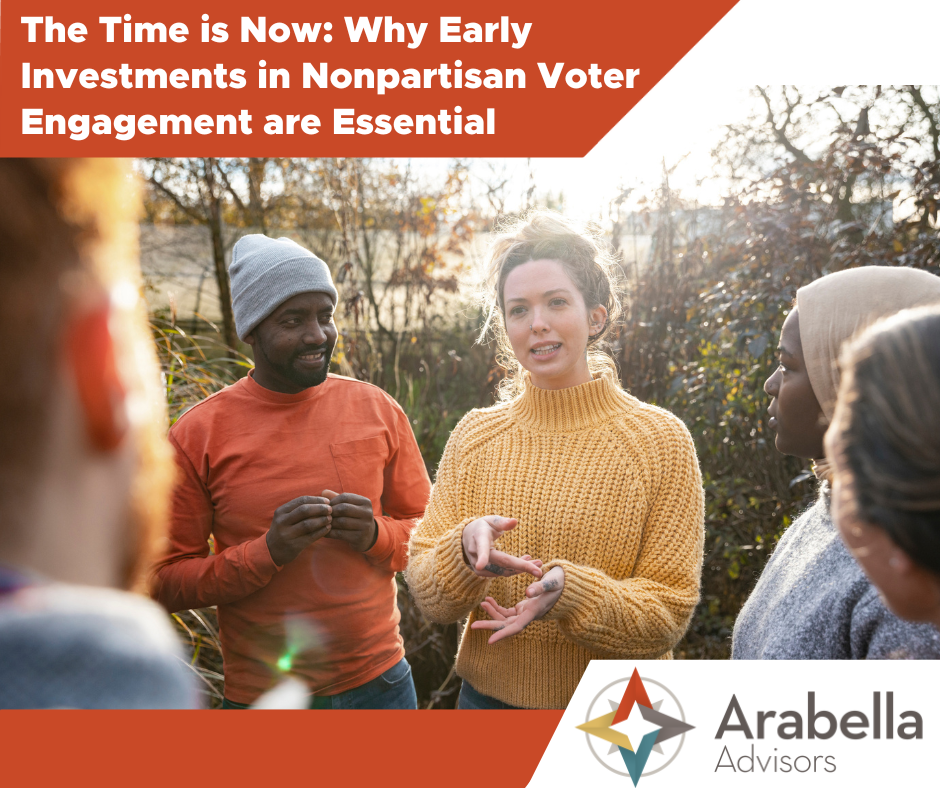The Time is Now: Why Early Investments in Nonpartisan Voter Engagement are Essential

An engaged, informed voting public is crucial to a healthy and thriving democracy. That’s why investing in nonpartisan civic engagement early and consistently is critical, regardless of whether it is an election year. Nonpartisan voter engagement aims to educate and encourage active participation from voters in the electoral process, without connecting to a particular candidate or party. This civic mission transcends party lines and is vital for a flourishing, effective democratic process.
Voter engagement gives folks a voice; it helps the public realize the opportunity to champion the causes they care about—both at a national level, like tax policy, or locally, such as by voting for school board candidates who represent the kind of education system people want for their families and neighbors.
To maximize the effectiveness of investments in voter engagement, funders should aim to get dollars out the door as soon as possible—well ahead of presidential elections or other election-related inflection points. By initiating this work before pivotal moments in the electoral landscape, organizations on the frontlines of civic, social, and electoral work can make needed infrastructure investments and develop strategic plans that lay groundwork and establish momentum. This is what keeps communities civically engaged and participating in the work of democracy in a deep, meaningful way.
Below we highlight three reasons why it is important for funders to start investing in nonpartisan civic engagement as soon as possible, along with tactics to maximize the impact of your gift.
Early, unrestricted funding provides civic organizations, particularly grassroots groups, with ample lead time to develop and deploy strategic plans.
In the fast-paced world of advocacy and social change, timing is crucial. Early and sustained investment allows organizations to lay the critical groundwork for such efforts before they become visible to the public. By providing early, unrestricted funding, organizations can hire staff, develop strategies, implement systems, and train their teams to create enduring and impactful programs. Donating unrestricted funds to support all costs associated with operating a nonprofit sends a clear nonpartisan message, emphasizing the importance of civic engagement in and of itself, unrelated to party preference. This kind of giving allows organizations to continue building voter engagement beyond any specific election or candidacy.
Multiyear funding enables organizations to build and sustain momentum by developing, testing, and refining their programming in response to what is and isn’t working on the ground.
Multi-year funding enables organizations to strategize and invest beyond a 12-month election cycle, freeing organizations to implement complex, longer-term strategies without having to jump in and out of the work. When these community-embedded organizations can avoid the stark drop-off in funding following an election year, an issue known as the “boom and bust cycle,” they avoid the fluctuations that make it difficult to maintain momentum. A crucial component of this sustainability and effectiveness is staffing. When underfunded, nonpartisan voter engagement organizations are left to rely on mostly volunteer workforces; however, consistent funding allows them to hire enough full-time staff to sufficiently build out and enact strategies, provide continuity and build institutional knowledge, and avoid onboarding and training delays. With this in place, grassroots organizations can thoughtfully involve the full spectrum of voter styles— from skeptical to hyper-engaged. Engaging the full range of voters allows democracy to flourish and provides representation genuinely reflective of the communities served.
Early funding helps position grassroots organizations as regular, trusted fixtures in the community, building civic trust during and outside of election cycles.
Grassroots organizations are most effective when they are—and are seen as being—deeply and authentically embedded in their communities. This enables them to fully understand the communities’ issues and the unique context surrounding them. But to engage in an authentic and sustained way, grassroots organizations need year-round funding—specifically, increased funding that arrives well before large elections so they can step up their work and build trust with community members.
Building trust takes time. This is especially important for groups working in communities of color and other historically marginalized communities. Once these organizations have established themselves as reliable, credible partners, they can validate and reassure their communities members that elections are safe, worthwhile, and trustworthy—a vital goal in the current age of disinformation. And, importantly, early funding allows grassroots organizations to engage their communities before the presidential candidates are finalized, which demonstrates the organization’s transparency and nonpartisanship. Consistent funding also builds community buy-in. When communities lose visibility into the activities of local organizations due to the waxing and waning of funding, those groups lose credibility with the communities they serve.
The significance of early, multiyear, and unrestricted investment in nonpartisan voter engagement cannot be overstated when it comes to safeguarding the health and vitality of our democracy. By encouraging voter engagement and education, we foster a political landscape that prioritizes the voices and concerns of the electorate.
Eager to learn more? Don’t hesitate to reach out.
